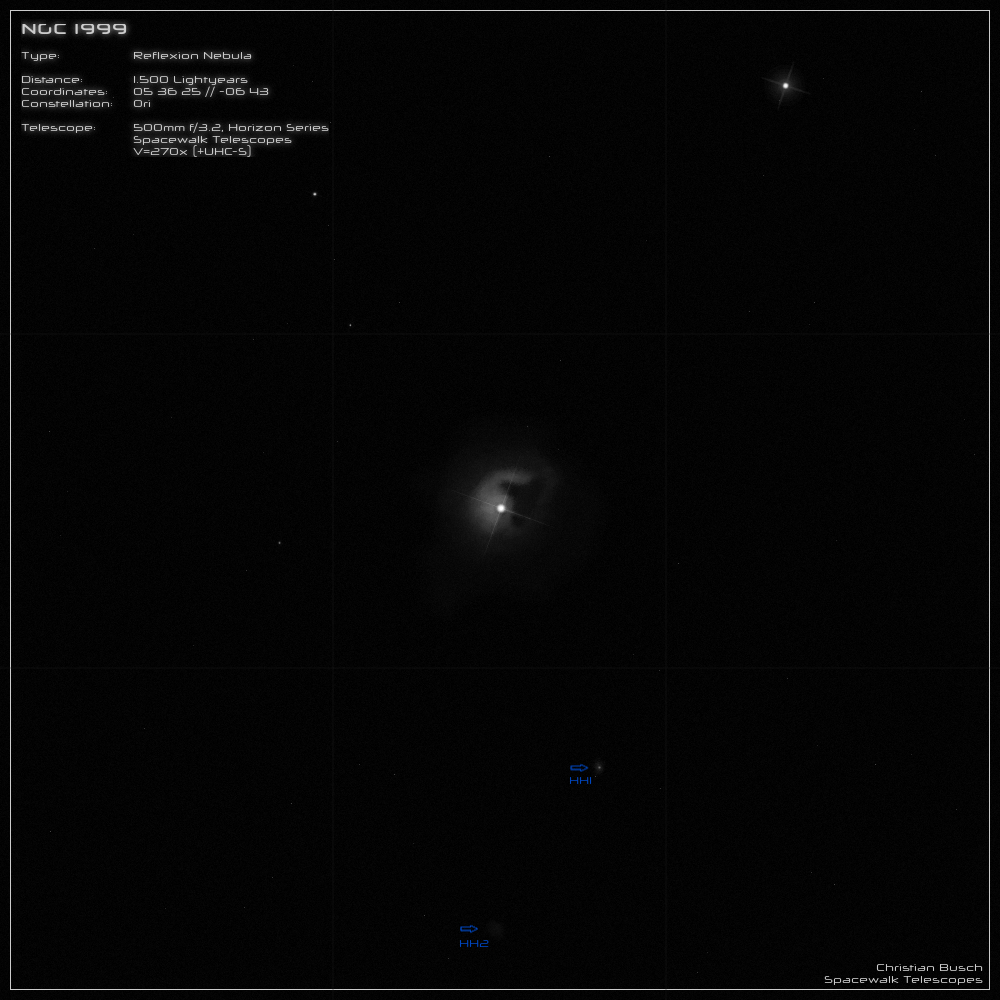NGC 1999 - Reflection Nebula
NGC 1999 is a reflection nebula in the constellation Orion with an apparent size of 2x2' ("arcminutes") that is located 1,500 light-years away from Earth.
It was discovered in October 1785 by F.W. Herschel with his 19" Reflector.
The true diameter of the nebula is about 0.9 light-years. It is very dusty and has a rather dark area in its center, which is why the object is sometimes
called "keyhole nebula". Initially it was thought that some dust in front of the nebula is very dense and therefore blocks the light of the nebula completely. But
in the meantime it has been found out that the dark hole is just totally empty. The reason for this is still a subject of research. Some theories assume
that jets from young stars "blew" the material out of the nebula and thus created the cavity. But also older stars with their strong radiation could be
reponsible for this.
By the way, the nebula is shining because the contained dust particles reflect the light of the nearby bright star.
The star "V380 Ori" is only 1-3 million years old and therefore extremely young. It belongs to the group of Ae/Be stars, has spectral class of B9...A1
and a variable brightness in the range of m=10.2...10.7mag. V380 is about 2.9x as heavy as the Sun, about 3x as large and shines 100x as bright.
The temperature at the surface is a hot 10,500 Kelvin. But V380 is not a single star, it belongs at least to a triple star system. The second component
orbits the main star at a distance of 50 million kilometers once in 104 days, while the third component is more than 9.3 billion kilometers away.
South of NGC 1999 we find the Herbig-Haro object "HH1/2", which is the brightest of this category in the sky. It consists of two shock fronts moving
away from each other in opposite directions. At the moment their distance is 1.1 light-years. Some parts of the nebula reach velocities of more than 400
kilometers per second. In the center of HH1/2 there are several very young stars, but they are only visible in the IR because of the very dense dust. Some
of these stars show jets which drive the shock fronts outward.
----------------------------------------------------------------------------------------------------------------------------------------------
NGC 1999 offers a very exciting and beautiful view in my 20" f/3.2 telescope. The nebular masses shine very bright and can be traced over a large distance
with averted vision. The area around "V380 Ori" appears brightest, but the area north of the keyhole is also very prominent. More difficult, however, is the
western edge of the dark inner region, which appears only slightly hinted. The whole nebula gently fades out into the surrounding space and has an
irregular shape.
Also noticeable is the lack of stars, which is probably due to all the dust.
The two Herbig- Haro objects are not very conspicuous and are best seen at a magnification of 270x. HH1 is relatively easy to see and much brighter than HH2.
It appears slightly elongated and featureless, and you can also see a bright knot in the center that looks like a faint star. HH2, on the other hand, is not so easy to
see even with averted vision. It appears quite small, featureless, slightly oval and homogeneous at this magnification.

